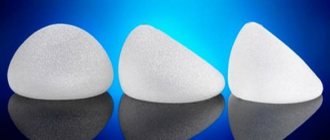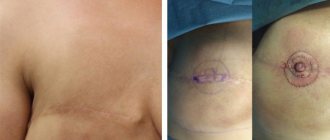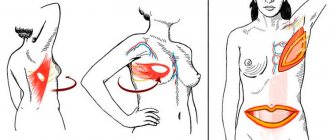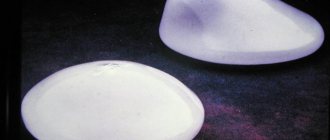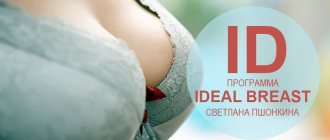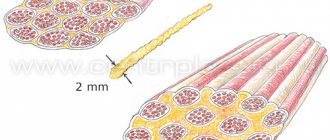Breast augmentation, or breast augmentation or augmentation mammoplasty, is a surgical procedure aimed at increasing the size, shape or fullness of the breast.
To enlarge the breast, the plastic surgeon places breast implants filled with special silicone, saline or biocomposite material under the pectoralis major muscle or under the breast tissue. Modern implants can last the patient's entire life, and most manufacturers offer a lifetime warranty on their implants.
How it's done
Before making a decision, you need to clearly understand what this procedure is and how it is performed.
First, a woman needs to undergo an examination with consultation from various specialists and undergo a series of tests. Diseases such as diabetes, oncology, mastopathy, hypertension and varicose veins are an absolute ban on surgery.
Having overcome this stage and received permission, the woman will have to decide on the size and shape of the implant. Drop-shaped samples with a volume of 200 ml look most natural, which allows you to make your breasts one and a half times larger. Science does not stand still and modern implants are highly reliable; the most common is considered to be a filler in the form of a highly responsive silicone gel, which is durable, has excellent shape memory and is soft.
The operation itself is performed under general anesthesia for about 2-3 hours. All details of the procedure, namely the location of the incision and location, are discussed in advance.
Are silicone implants dangerous?
Many people probably remember that in the early 90s, a scandal surrounding silicone implants erupted in the United States: there were reports that silicone causes such serious diseases as malignant tumors and collagenosis (roughening and hardening at the sites where the implant is installed). Thousands of women began to go to court. The company that produced these implants was forced to pay huge sums of compensation for damage caused to the health of patients. And silicone implants were banned in the USA with one exception: they were allowed to be installed during breast reconstruction after cancer surgery.
The rise of silicone implants
In 1999, the US Institute of Medicine, based on numerous scientific data, made a statement that silicone does not cause chronic diseases, does not pass into breast milk and does not cause cancer.
Studies conducted around the world (no one banned silicone implants in other countries) also showed that women with prosthetics and women without prosthetics have the same risk of developing breast cancer. However, the US Institute of Medicine has warned that silicone, if it gets into the body's tissues, can cause some complications (for example, inflammation) requiring surgical intervention. Today, experts say that when using new, better implants with a durable shell, there is a risk of complications. minimal. Most Russian plastic surgeons who have continued to use silicone implants believe that although they are not ideal, they are still the best - soft, comfortable and convincingly imitate breasts. As for the scandal raised around them in the United States, many doctors believe that it was created artificially.
You can sign up for a free breast augmentation consultation with Dr. Ross here
Breast surgery: green light
This procedure is advocated primarily by women who believe that by increasing their breast size from 1 to 4, they will have a better chance of improving their personal life. Many people start a career as a fashion model or get married successfully. Mammoplasty helps women with various breast problems: asymmetry of the mammary glands, congenital breast malformations, mastectomy. According to professional plastic surgeons, the dangerous consequences are increasingly exaggerated, since if you follow all the recommended instructions, you can lead a completely normal life, and such examples as rupture of implants are just isolated cases of poor-quality services.
Problems of non-surgical breast augmentation
Previously, to correct the mammary gland, a shell-free gel was used, which was “pumped” with a syringe into the area between the muscle and the mammary gland. As a result, the breasts increased right before our eyes and at the same time in patients
there were no scars left. However, this gel interacted with tissue fluid, which could lead to inflammation and suppuration. In this case, operations had to be performed that literally mutilated the patients. In addition, the injected gel formed lumps and “walked” throughout the body. And it was almost impossible to remove it from tissues. It is for these reasons that in all developed countries of Europe and in the USA the use of gels that are not enclosed in an impermeable shell was strictly prohibited.
Breast surgery: red light
Conventional surgeons and psychologists oppose breast mammoplasty, arguing that breast enlargement does not make a woman happy and can have serious consequences for the body. The fact is that the implant may not take root, and this happens quite often, which will require repeated surgery to remove them. In addition, abusing general anesthesia is also very dangerous; cases of poor tolerability of the procedure have been proven. Another argument against it is that the breasts may lose sensitivity and this is often irreversible. Opponents of mammoplasty recommend first contacting a psychotherapist, since sometimes the problem is not breast size at all.
Be that as it may, each woman decides individually whether to undergo breast surgery or not; the main thing is that she should be familiar with all the advantages and disadvantages.
Foreign and domestic stars often resort to such operations; we don’t know whether this is due to maintaining their image or simply a desire to distinguish themselves. But we bring to your attention three striking examples of celebrity mammoplasty:
Anastasia Zavorotnyuk
The 45-year-old Russian star does not confirm her appeal to plastic surgeons, however, it is impossible not to notice it. The experiment turned out to be successful, curvy shapes look quite natural.
Pamella Anderson
The Hollywood celebrity can be called a pioneer of mammoplasty; perhaps, it was with her that many Russian women began to want to undergo breast surgery. At 49 years old, Pamella has undergone breast correction several times and has finally brought it to perfection; now her breasts look beautiful and realistic.
Christina Aguilera
The American singer and actress is 36 years old, and she had her very first operation at the age of 18. Thanks to the surgical transformation, Christina’s bust increased by two sizes at once and many believe that this is what added to her popularity. Aguilera underwent repeat mammoplasty relatively recently, after giving birth, to correct her shape.
Breast cancer, harm from bras and cosmetic surgery: an interview with a mammologist
If a woman is diagnosed with breast cancer before the age of fifty, or if she has many family members with breast cancer or other cancers, there is a reason to be tested for a genetic mutation in the BRCA1 and BRCA2 genes. However, modern technologies make it possible to choose a study that will not be much more expensive, but will be more informative and will cover the issues of hereditary oncology in principle. Analysis of BRCA1 and BRCA2 does not look at the entire gene sequence, but only looks for so-called common mutations. But the genes themselves and their product - the BRCA1 and BRCA2 proteins - are huge, they include more than a thousand amino acids, and a breakdown in any part of the gene can be responsible for the development of cancer. You can pay a little more money and look not at two genes, but at one hundred and seventy, for which today a connection has been established between defects in them and the development of various forms of oncology.
Does breast removal help fight cancer?
Maxim Ignatov, mammologist: The hereditary risk of breast cancer is the only basis for preventive removal of the mammary glands. In Russia, this is only possible if you have a positive test for a mutation in the BRCA1 or BRCA2 genes. Preventive removal is indeed justified, because with such mutations the risk of developing cancer is very high.
Are cosmetic surgeries dangerous?
Maxim Ignatov, mammologist: Breast reduction operations (reduction mammoplasty) and breast lift (mastopexy), for example, when its size is so large that it is simply difficult to wear it, especially for older women, are practiced and are absolutely safe.
Breast augmentation is also absolutely safe, since it does not affect the mammary glands - the implant is installed under the muscle. This does not affect the structure or function of the mammary gland in any way. Difficulties can only arise with mammography - squeezing the breast into the machine can become problematic, but you still won’t be able to damage the implant.
Nowadays there is a lot of discussion around the dangers of wearing a bra. This is true?
Maxim Ignatov, mammologist: Wearing a bra really affects the condition of the breasts - if the breasts are tightly tightened, especially underwear with hard underwires. In addition to the fact that this is traumatic and causes discomfort, it also contributes to lymphostasis - stagnation of lymph in the mammary glands. Refusal to wear a bra cannot have a negative impact, nor can switching to underwear without wires.
How are breast sensations related to menstruation?
Maxim Ignatov, mammologist: Before menstruation, some women often experience chest pain and a feeling that it is “pulling.” This is due to increased estrogen and the effect of estrogen on breast tissue. It causes swelling and increased blood filling. Unpleasant sensations are caused by hormonal imbalance. This condition can be prevented with the help of local progesterone in the form of a gel in preventive courses, this gives a good effect.
Another popular belief is that breastfeeding prevents breast cancer. Is it true?
Maxim Ignatov, mammologist: This is partly true. Pregnancy, childbirth and subsequent lactation are good prevention of breast cancer. However, if a woman does not want or cannot breastfeed, refusing to breastfeed will not entail any significant consequences. Lactation can be stopped with medication.
There are times when breastfeeding is not recommended or even prohibited. For example, you cannot feed during the acute period of lactation mastitis, when there is inflammation and there is a high probability of bacterial contamination of the milk. As for infectious diseases, you can’t feed someone with HIV; in this case, artificial formula completely compensates for all the child’s needs. For hepatitis C, the risk of infection through milk has not been proven, but I would still recommend refraining from breastfeeding.
Does breast size affect milk supply? And is it possible to predict even before the birth of a child whether a woman will have problems with lactation?
Maxim Ignatov, mammologist: No, it’s almost impossible to predict before birth. And breast size also has no effect on milk production. The mechanism for stimulating lactation is triggered with the help of pituitary hormones, the breasts grow quite quickly. Breast size is not important, what is important is the amount of stimulating substances - those same hormones.
During transfeminine transition, while taking hormones, the transwoman's breasts begin to grow. Is it different from natural female?
Maxim Ignatov, mammologist: Such breasts arise, essentially, from a rudiment, and they differ from the natural female breast. Functionally, it is, of course, imperfect, since it was originally rudimentary. At the same time, breast cancer directly depends on hormonal stimulation, and transgender transition involves the use of hormone therapy in large doses. Therefore, the risk of developing breast cancer may increase after transgender transition.
Men's attitudes towards breast surgery
Much has been written about the attitude of men to the issue of breast enlargement and there is still no consensus. Some like breasts the size of a man's palm, others like busty young ladies, and some cannot distinguish artificial breasts from real ones. But most men agree on one thing: a woman’s breasts should be liked by the woman herself and be well-groomed, and the overall attractiveness of the chosen one does not depend on its size.
The Russian Doctor company will help you take care of your health and breast condition. With us, every representative of the fair sex is guaranteed assistance from a highly qualified healthcare specialist! Just fill out the application on the website.
- Daria Bogdanova
- Plastic surgery
Types of implants for breast enlargement.
Modern implants for the correction of mammary glands are a silicone shell, inside of which there is a filler - the latter is most often used so-called bonded silicone. This is a soft, mushy suspension, which is good because it does not spread even in the exceptional case if the shell suddenly breaks. Another commonly used vehicle is saline (0.9% salt in water). Such implants are either valved or valveless. Empty valve implants are inserted in a rolled-up state under the mammary gland and then filled with saline solution. Their disadvantage: over time, the valve begins to let the solution through and with sudden movements it gurgles and squishes. And that is why valveless prostheses have recently been used, which have virtually no drawbacks, except for one thing - they feel much denser to the touch than implants filled with silicone. Sometimes blood substitutes, soybean oil and others are used as fillers.
Silicone gel implants
These implants are less likely to wrinkle than saline implants. The polyurethane-coated type is said to reduce the risk of implant rotation or scar tissue affecting the shape of the implant.
However, if a soft gel silicone implant ruptures, the silicone can penetrate into the breast, causing silicone granulomas. The implant will need to be removed if it ruptures. Polyurethane-coated implants may also cause a temporary allergic reaction.
While new silicone implants are less likely to leak into the breast if they rupture, it is difficult to determine when this will happen. The NT-Medicine Clinic and our plastic surgeons recommend magnetic resonance imaging (MRI) to detect implant ruptures 3 years after their placement, and then every 2 years thereafter.
In order to get beautiful breasts, you always need to get an implant.
This is not true: you can restore a beautiful breast shape without installing an implant. To do this, you can perform operations such as lipofilling or breast lift. The surgeon determines what type of correction will be required. If there is a sufficient amount of glandular tissue, a breast lift can be performed, for example, after childbirth and breastfeeding. To increase breast size, you can use the technique of pumping in the patient’s own fat – lipofilling.
Only if there is a lack of glandular or adipose tissue, implants are used.
Too big breasts. What to do?
Other women are tormented by the exact opposite problem: nature has endowed them too generously - with a chic, lush bust. True, some of them suffer to a greater extent not because it causes them some kind of inconvenience (for example, when playing sports), but rather because of... the stronger sex. It seems to some that their breasts “repel” men, to others, on the contrary, that they only look at a large bust... But besides psychological reasons, there are, of course, others. It is difficult to choose clothes and underwear - a lot of things have to be made to order. But the most serious problems are pain in the spine, skeletal deformation, and breathing problems.
What is mastopexy?
What about those women who are quite happy with the size of their breasts, but are not satisfied with the shape? For example, after lactation, the skin stretches, the gland tissue hypertrophies and the breasts sag. In this case, breast tissue tightening - mastopexy - can help. There are several options for performing this operation, but the essence comes down to one thing: excess skin in the lower part of the gland is removed, due to which the shape of the breast improves, the nipple and areola move to their normal position. However, quite often it is necessary to do mastopexy with simultaneous enlargement of the gland by implanting endoprostheses. This way, excess stretched skin is removed and beautiful breasts are formed.
What to consider before installing implants
Breast implants may interfere with future breastfeeding. Which happens extremely rarely.
Breast implants come with a lifetime warranty against implant rupture without injury. Other complications may occur at any time, which may result in the need to remove or replace the implant at the patient's expense.
If complications occur, corrective surgery may be required, and the results of this surgery may be similarly unsatisfactory.
If you are considering breast surgery, weigh the pros and cons of having implants and evaluate any risks. Think about whether you should have surgery and how you will feel and cope if complications arise.
Up to 20 percent of women who decide to have breast implant surgery have them removed within 8-10 years.
If the implants are removed and not replaced, the breasts may appear wrinkled, saggy and dull. Since with age there is a natural stretching of the skin, the volume of the implant that was installed at 20 years old at 35 may no longer be enough to give a beautiful shape to the mammary gland.
Breast reduction.
Breast reduction surgery is called reduction. There are many methods for performing it, which differ mainly in the shape and position of the incisions on the mammary gland. But if during endoprosthetics one small incision is made, then during reduction the incisions are quite large and as a result scars remain, which over time can stretch under the own weight of the breast if the patient does not follow certain recommendations. In addition, after such an operation, loss of the ability to lactation is possible, since many milk ducts are removed. And therefore (if there is no gigantomastia), surgeons try to dissuade women from reduction, especially those who have not given birth.
Methods of inserting implants. When is breast augmentation through the axillary approach not possible?
Implants vary in shape (mostly round and teardrop-shaped) and sizes. There are three ways to administer them, depending on the location of the skin incision: through the fold under the mammary gland, through the armpit and through the lower half of the areola. Which one is preferable is decided by the surgeon, taking into account a number of factors. For example, with a large volume of implants, the doctor is forced to abandon a more cosmetic operation (insertion through the armpit). The operation is performed under general anesthesia. The implant is placed either under the breast tissue or under the pectoralis major muscle - this way it does not even come into contact with the breast tissue, which completely eliminates the possibility of complications and allows you to breastfeed your children in the future.
Dr. Ross performs 80% of breast augmentation operations using the axillary approach.
Breast lipofilling: gradually and little by little
Lipofilling technology involves multiple microinjections into different points of the corrected area.
The most important thing you should know about lipofilling: the more adipose tissue is transplanted at one time, the worse its survival rate and the prognosis for its residual volume in the long term. Transplanted tissue that moves to a new location should be surrounded as much as possible by microvessels and “native” breast cells. Otherwise, it does not completely take root - the fat either resolves or is destroyed and is subsequently replaced by connective tissue (which, of course, does not give very good tactile sensations).
That is why transplantation of small portions of adipose tissue is considered favorable. If during lipofilling fat is injected in a single volume, the chances that the volume will take root tend to zero.
This suggests an important conclusion. Breast lipofilling is an extremely relevant technology, but only when it comes to eliminating minor aesthetic defects. So, lipofilling will work great if you want to enlarge your breasts, but just a little. Or if after mammoplasty there is a contour defect or slight thinning of the covering tissue above the implant (which makes the implant noticeable). In such cases, local transplantation of a small amount of adipose tissue to camouflage an aesthetic defect is a real salvation.
By the way, the situation is absolutely similar with lipofilling of the buttocks. This method can correct minor imperfections (delicate contour correction), but to get beautiful shapes - only the gym!
Early signs of complications
Complications to watch for may include redness of the skin and unusual swelling that does not go away.
Early signs that something may have gone wrong with breast implant surgery include:
- redness of the skin around the breasts
- unusual swelling that does not go down
- burning
If you notice any of the above symptoms, you should immediately contact the clinic where the surgery was performed.
If you are concerned that the surgery was not performed correctly or are unhappy with the results of the surgery, you should contact the surgeon who performed the procedure.



